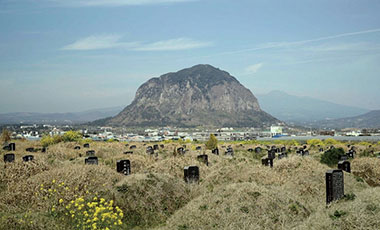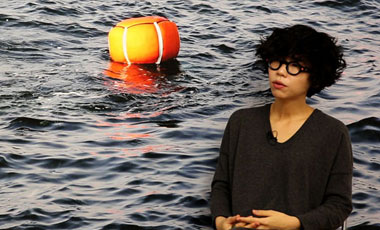Kim Hae-ju : Fever Variations, from the 2006 Gwangju Biennale, was an Asian-themed exhibition. Gwangju is also the place where the Asian discourse wave has really flourished since the Asian cultural hub city project began. Would you say the 2006 Gwangju Biennale was a kind of suggestion and response to answer the demands and questions of a region searching for “Asian-ness”?
Kim Hong-hee : There were general discussions about an Asian hub city, but the idea was less about connecting with that than about the 1990s being a period when Asia changed, when there were historic transformations in Korean contemporary art. You could argue that the Asia phenomenon from the 1990s is still going on, since all the new biennial events are appearing in different parts of Asia. There was already a kind of “hunger for Asia” at the time, but I never got the sense that any special meaning was being given to the idea of having Asia as a theme. It wasn’t about introducing “Asian-centered thinking” because I’m Asian; I wanted to address Asia from the perspective of a place that is transforming, that is undergoing a change in identity. Now, as an Asian curator, I did think about how to create a sense of difference specific to Asia. I settled on two venues, “root” and “route,” as a way of conceptualizing the fluidity of Asian identity. This dual identity, overlaying one identity with another through the themes of “root” -- an indisputable Asian tradition -- and “route” -- the creation of a new identity -- was a way of showing what Asia is. The director Park Chan-kyong recently put Asian discourse front and center once again in preparing for next year’s Seoul International Media Art Biennale. The idea of the “post-museum,” which is the Seoul Museum of Art’s guiding vision, is valid also as a vision for contemporary art museums not just in Korea but throughout Asia. That makes the question of how to establish a dual identity a key concern.
Kim Hae-ju : When did you leave SSamzie?
Kim Hong-hee : It was 2008. I became director of the Gyeonggi Museum of Modern Art in 2007, and I left SSamzie the next year. Part of it was that SSamzie’s business was hurting, but a bigger reason was that I’d done pretty much everything I could do over those ten years. It would have been redundant to bring it up all over again. I really though that SSamzie would lose its energy if we didn’t come up with a new paradigm. As it happened, I hit on the idea of the Gyeonggi Creation Center at the Gyeonggi Museum of Modern Art. My idea was to seek a new paradigm shift in that center, a public residency, and use it to power a transformation in the art museum.
Kim Hae-ju : For more than 15 years, you’ve been bearing witness to transformations in the residency format. There definitely still is a need for residencies in the artist’s working environment, but it also seems like they’ve lost a lot of their vitality.
Kim Hong-hee : They’ve become very institutionalized. But I’d actually like to view the present as a kind of new residency period. Alternative spaces have been doing a lot of things over the past decades, but they’re also exhausted from trying to find sources of funding to keep going. Support dropped by half going from the Roh Moo-hyun presidency (2003-08) to Lee Myung-bak’s (2008-13). The people actually running the alternative spaces have fallen on very hard times. One way of helping turn that around is to change the format and give a greater alternative role to museums that are part of the system and have the basic budget of a public institution.
Kim Hae-ju : The Seoul Museum of Art program suggests an attempt to support a wide range of generations in the art community. At the same time, a public art museum also has to think about drawing in a diverse public. As an originator of innovative ideas, how do you coordinate between the art museum’s role and its public service function? How do you determine where it stands?
Kim Hong-hee : What I envisioned was a “post-museum,” but it’s run according to a kind of “ambidextrous” philosophy. The only way to achieve innovation is by being ambidextrous -- respecting the stability of the government bureaucracy and the history of the art museum, while blending in the leader’s innovation. If you don’t have support for this kind of innovation, then it’s not going to work, no matter how hard you try. So it’s about combining the two aspects -- the administrative ability and stability of the bureaucracy and the innovation of the art -- and modulating that clash. The exhibition planning at a public institution is closely linked to a coordination of these two aspects -- the ambidextrous approach, the glocal, the combination of the orthodox and the alternative.
Kim Hae-ju : You’ve talked before about the difference between “directorship” and “curatorship.” You also wrote that someone working as a director also needs to maintain the spirit of an independent curator. I’d like to hear more about what you meant by that.
Kim Hong-hee : To be innovative as a director, you need to have the independent curator’s mind -- independence, but at the same time the concept of artistic culture as an alternative. So my experience as an independent curator who became an establishment museum director has great significance to me. I don’t think of myself as a bureaucrat director. I consider myself a museum director who is also a kind of independent curator, someone who can bring about changes in the museum.
Kim Hae-ju : There are some critics who acknowledge the pure function of the art museum, but who feel it’s still a kind of market indicator, that it loses the experimental aspect and just runs through similar types of programs over and over. How do you see the future of the art museum?
Kim Hong-hee : The reason the “establishment museums” draw so much flak is because of their history of being white male-centered, elitist organizations for the wealthy and powerful. It’s only relatively recently that it’s become accessible to more ordinary people. The “post-museum” is about becoming an institution that is more person-centered, more inclusive of the elderly and disabled persons. The key issue is less the aesthetic or financial value of the collection than the relationship it forms with people, whether it can impact lives and improve their quality. The same goes for the exhibitions. There are two aspects to them: one is about drawing the public into public museums, but another import role involves elevating their artistic sense, so you have to maintain a high quality of exhibitions. You also need to develop mechanisms to mediate communication between the work and the viewer. It needs to be something more proactive than the conventional tools of the art museum -- things like captions, annotations, docents. I also think we need to share art from the second and third worlds. So we plan exhibitions that focus on Scandinavia, Africa, the Arab world, and South America, but we’re envisioning exhibitions that are post-genre, including things like design, architecture, and fashion.

Kim Hae-ju : You recently took part on the committee to select an artistic director for the Kassel Documenta exhibition. Can you talk about the process?
Kim Hong-hee : I’m not even sure how I got the invitation. But I do think the presence of an Asian on the selection committee is a testament to the positions of Korea and Asia today. What I really sensed from participating there is that having a serious selection process and system has been fundamental to Documenta surviving intact despite all the changes it has gone through since it began in 1955. They brought on review committee members who were curators and directors from eight different countries, and each of them did research and came up with recommendations for four to five artists, giving them a basic pool of around thirty to forty. Then it got condensed again, and there were about four or five selection processes, with research and presentations on the list, along with a lot of intense discussion. I had the sense that I needed to “represent” Asia, and my emphasis was first and foremost on getting away from Eurocentrism. But all the Asian candidates ended up getting cut. Even where we are getting away from a focus on Western Europe, it still seems to be limited to Eastern Europe, Africa, and South America. I do feel like it’s time for Documenta to have an Asian director, but I do recognize that there is a certain objective lack of experience. I look forward to seeing which Korean or Asian curators might be able to do something like Documenta in the future.

Kim Hae-ju / Independent Curator
Kim Hae-ju is an independent curator. She has worked as a researcher for the National Theater Company of Korea’s academic publishing division and assistant curator at the Nam June Paik Art Center. Her exhibitions include Memorial Park(Palais de Tokyo and Paris, 2013), Sand Theater(from Playtime, Culture Station Seoul 284, 2012), and The Whales -- Time Diver(National Theater Company of Korea, 2011).


